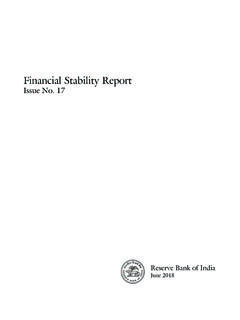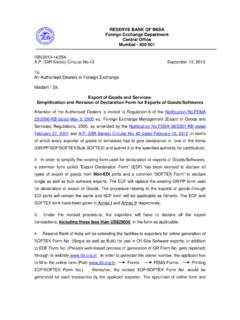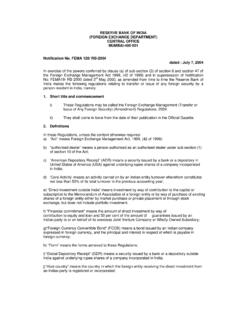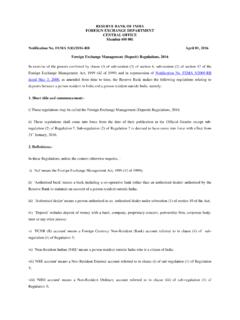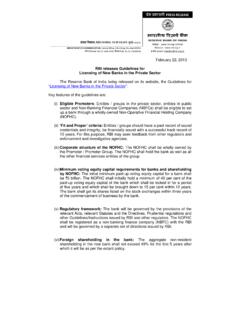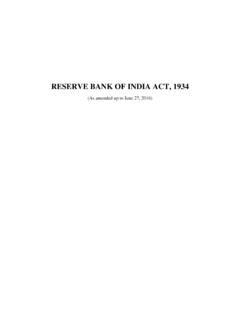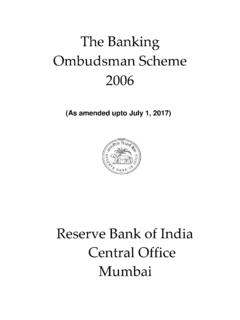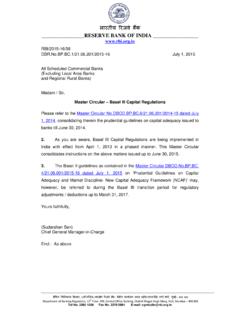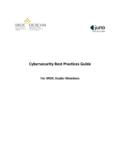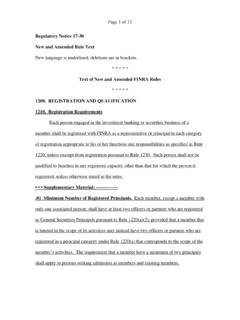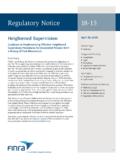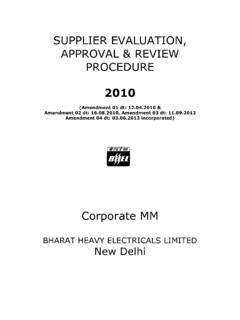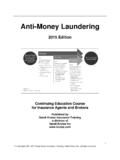Transcription of PRESS RELEASE - rbidocs.rbi.org.in
1 1 PRESS RELEASE , , .. , -400001 _____ DEPARTMENT OF COMMUNICATION, Central Office, , Mumbai-400001 /Phone: 022- 22610835 /Fax: 91 22 22660358 RESERVE BANK OF INDIA 0 : Website : - email: April 05, 2018 Statement on Developmental and Regulatory Policies This Statement sets out various developmental and regulatory policy measures for strengthening regulation and supervision; broadening and deepening financial markets; improving currency management.
2 Promoting financial inclusion and literacy; and, facilitating data management. I. Regulation and Supervision 1. Mandatory Loan Component in Working Capital Finance With a view to promoting greater credit discipline among working capital borrowers, it is proposed to stipulate a minimum level of 'loan component' in fund based working capital finance for larger borrowers. Draft Guidelines are being issued for feedback in this regard. 2. Countercyclical Capital Buffer The framework on countercyclical capital buffer (CCCB) was put in place by the Reserve Bank in terms of guidelines issued on February 5, 2015 wherein it was advised that the CCCB would be activated as and when the circumstances warranted, and that the decision would normally be pre-announced with a lead time of four quarters.
3 The framework envisages the credit-to-GDP gap as the main indicator, which may be used in conjunction with other supplementary indicators, viz., the Credit-Deposit (C-D) ratio for a moving period of three years (given its correlation with the credit-to-GDP gap and GNPA growth), industrial outlook (IO) assessment index (with due note of its correlation with GNPA growth), and interest coverage ratio (noting its correlation with the credit-to-GDP gap). Based on the review and empirical testing of CCCB indicators, it has been decided that it is not necessary to activate CCCB at this point in time.
4 2 3. Deferment of Indian Accounting Standards (Ind AS) implementation Scheduled Commercial Banks (SCBs), excluding Regional Rural Banks (RRBs), were required to implement Indian Accounting Standards (Ind AS) from April 1, 2018 vide our Circular dated February 11, 2016. However, necessary legislative amendments to make the format of financial statements, prescribed in the Third Schedule to Banking Regulation Act 1949, compatible with accounts under Ind AS are under consideration of the Government.
5 In view of this, as also the level of preparedness of many banks, it has been decided to defer implementation of Ind AS by one year by when the necessary legislative changes are expected. 4. Storage of Payment System Data In recent times, the payment ecosystem in India has expanded considerably with the emergence of new payment systems, players and platforms. Ensuring the safety and security of payment systems data by adoption of the best global standards and their continuous monitoring and surveillance is essential to reduce the risks from data breaches while maintaining a healthy pace of growth in digital payments.
6 It is observed that at present only certain payment system operators and their outsourcing partners store the payment system data either partly or completely in the country. In order to have unfettered access to all payment data for supervisory purposes, it has been decided that all payment system operators will ensure that data related to payment systems operated by them are stored only inside the country within a period of 6 months. Detailed instructions will be issued in this regard within one week. II.
7 Financial Markets 5. Access for Non-residents into the IRS Market Rupee Interest Rate Swap (IRS) market, while it is the most liquid among interest rate derivative markets, still lacks depth to enable large banks to manage risks. Thin participation and consequent absence of divergence of views result in pricing inefficiencies, which further discourages participation. At the same time, it is understood that there is an active market for Rupee interest rate swaps offshore. Also, Indian market has witnessed increasing participation from non-resident players like FPIs in debt.
8 With a view to develop a deep IRS market that accommodates divergent participants, it is proposed to permit non-residents 3 access to the Rupee IRS market in India. Detailed draft regulation will be issued for public comments by end of May 2018. 6. Introduction of Rupee S waptions In December 2016, RBI introduced Rupee Interest Rate Options (IRO), following the recommendations of the Apte Working Group. Only plain vanilla Interest Rate Options were allowed initially. Subsequently, market participants including corporates have expressed the need for swaptions to effectively manage interest rate risk.
9 Fixed Income Money Market and Derivative Association of India (FIMMDA) has conveyed a similar request on behalf of its members. It is, therefore, proposed to permit interest rate swaptions in Rupees so as to enable better timing flexibility for those seeking to hedge interest rate risk. The directions will be issued by end of April 2018. 7. Review of Separate Trading of Registered Interest and Principal Securities (STRIPS) directions The Reserve Bank introduced the Separate Trading of Registered Interest and Principal Securities (STRIPS) in Government Securities in April, 2010.
10 After some initial interest, the product did not find much favour with the market. With a view to encouraging trading in STRIPS by making it more aligned with market requirements and to meet the diverse needs of the investors, it is proposed to review these guidelines. The revised directions will be issued by end of April 2018. 8. Legal Entity Identifier (LEI) for Non-individual Market Participants The Legal Entity Identifier (LEI) code has been conceived as a key measure to improve the quality and accuracy of financial data systems for better risk management post the Global Financial Crisis.

